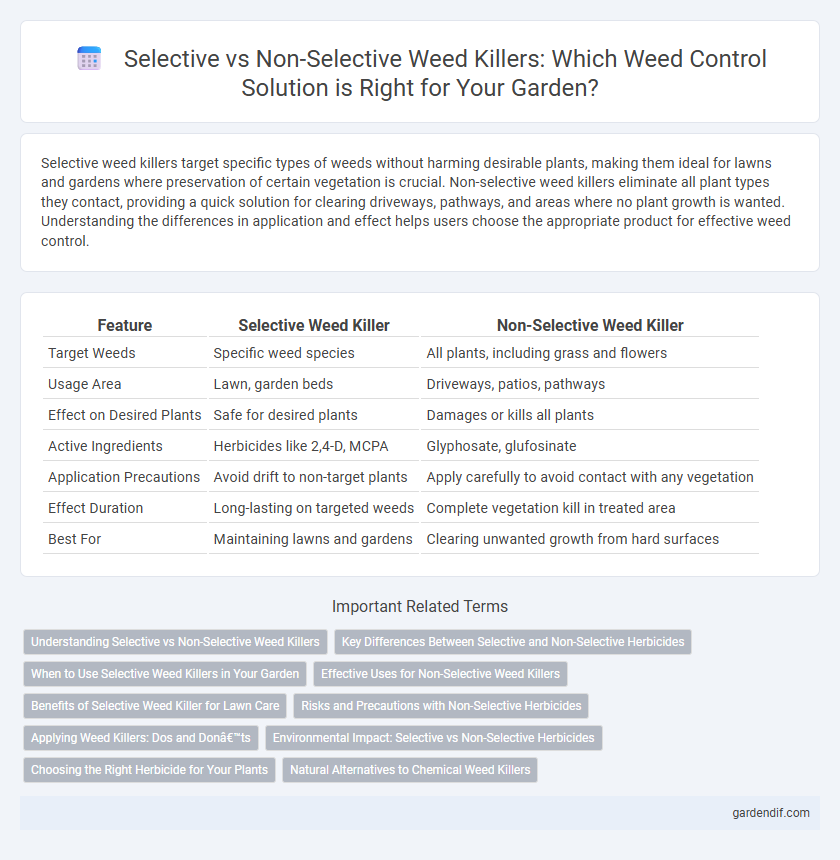
Selective weed killer vs Non-selective weed killer Illustration
Selective weed killers target specific types of weeds without harming desirable plants, making them ideal for lawns and gardens where preservation of certain vegetation is crucial. Non-selective weed killers eliminate all plant types they contact, providing a quick solution for clearing driveways, pathways, and areas where no plant growth is wanted. Understanding the differences in application and effect helps users choose the appropriate product for effective weed control.
Table of Comparison
| Feature | Selective Weed Killer | Non-Selective Weed Killer |
|---|---|---|
| Target Weeds | Specific weed species | All plants, including grass and flowers |
| Usage Area | Lawn, garden beds | Driveways, patios, pathways |
| Effect on Desired Plants | Safe for desired plants | Damages or kills all plants |
| Active Ingredients | Herbicides like 2,4-D, MCPA | Glyphosate, glufosinate |
| Application Precautions | Avoid drift to non-target plants | Apply carefully to avoid contact with any vegetation |
| Effect Duration | Long-lasting on targeted weeds | Complete vegetation kill in treated area |
| Best For | Maintaining lawns and gardens | Clearing unwanted growth from hard surfaces |
Understanding Selective vs Non-Selective Weed Killers
Selective weed killers target specific weed species without harming desired plants by exploiting differences in plant biology, making them ideal for lawns and gardens. Non-selective weed killers eliminate all vegetation they contact, effective for clearing unwanted growth in driveways or industrial areas. Understanding these distinctions ensures appropriate herbicide use, minimizing damage to beneficial plants and optimizing weed control.
Key Differences Between Selective and Non-Selective Herbicides
Selective herbicides target specific weed species without damaging desirable plants by exploiting differences in plant biology, making them ideal for lawns and gardens. Non-selective herbicides eliminate all vegetation they contact, used primarily for clearing driveways, paths, and industrial areas. Key differences include the range of affected plants, application areas, and potential impact on the ecosystem and surrounding flora.
When to Use Selective Weed Killers in Your Garden
Selective weed killers target specific weed species without harming desirable plants, making them ideal for use in mixed flower beds, lawns, and vegetable gardens where preserving non-weed plants is crucial. They are most effective when weeds are young and actively growing, ensuring precise control and minimizing damage to the garden's ecosystem. Applying selective weed killers during the early growing season helps maintain a healthy garden by preventing weed competition for nutrients, water, and sunlight.
Effective Uses for Non-Selective Weed Killers
Non-selective weed killers target a broad range of plants, making them highly effective for clearing driveways, patios, and large areas where all vegetation removal is desired. Products like glyphosate are commonly used for total vegetation control, eliminating weeds, grasses, and unwanted plants in non-crop areas. Their application ensures thorough weed eradication but requires careful use to avoid damage to desirable plants or crops.
Benefits of Selective Weed Killer for Lawn Care
Selective weed killers target specific weed species without harming the surrounding grass, making them ideal for maintaining a healthy and vibrant lawn. By preserving desirable turf while eliminating harmful weeds, selective weed killers promote stronger root development and improved lawn density. This precision ensures effective weed control with minimal damage to ornamental plants and grass varieties commonly found in residential lawns.
Risks and Precautions with Non-Selective Herbicides
Non-selective weed killers pose significant risks due to their ability to damage or kill any plant they contact, including desirable crops and garden plants. Precautions when using these herbicides include applying them carefully to avoid drift, wearing protective clothing to prevent skin contact, and using targeted application methods such as spot treatments or shielded sprayers. Proper storage and disposal are crucial to prevent environmental contamination and accidental exposure to humans and wildlife.
Applying Weed Killers: Dos and Don’ts
Applying selective weed killers requires precision to target specific weed species without harming desirable plants, ensuring effective control in lawns and gardens. Non-selective weed killers must be applied carefully only to unwanted vegetation, avoiding accidental damage to surrounding plants or soil ecosystems. Always read product labels, use protective gear, and apply under calm weather conditions to minimize drift and optimize herbicide efficacy.
Environmental Impact: Selective vs Non-Selective Herbicides
Selective weed killers target specific plant species, minimizing damage to desirable crops and preserving biodiversity in agricultural and garden ecosystems. Non-selective weed killers eliminate all vegetation they contact, increasing the risk of soil degradation and negative effects on non-target plants and beneficial insects. Environmental impact assessments show selective herbicides reduce chemical residues and promote sustainable land management compared to the broader ecological disruption caused by non-selective herbicides.
Choosing the Right Herbicide for Your Plants
Selective weed killers target specific types of weeds while preserving desirable plants, making them ideal for lawns and gardens with mixed vegetation. Non-selective weed killers eliminate all vegetation they contact, suitable for clearing driveways, patios, or preparing planting beds. Choosing the right herbicide depends on the plant species present and the area that needs treatment, ensuring effective weed control without damaging valued plants.
Natural Alternatives to Chemical Weed Killers
Selective weed killers target specific weed species without harming desired plants, making them ideal for maintaining flower beds and lawns. Non-selective weed killers eliminate all vegetation they contact, which can be harmful to surrounding plants and ecosystems. Natural alternatives like vinegar, essential oils, and corn gluten meal provide eco-friendly options that reduce chemical exposure while effectively managing weeds.
Selective weed killer vs Non-selective weed killer Infographic

 gardendif.com
gardendif.com